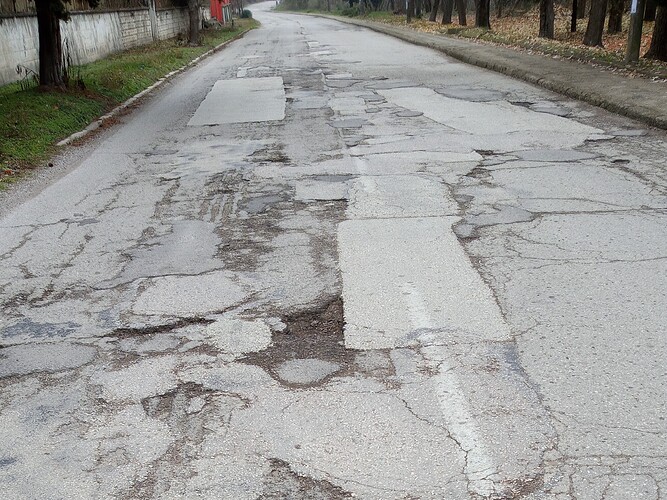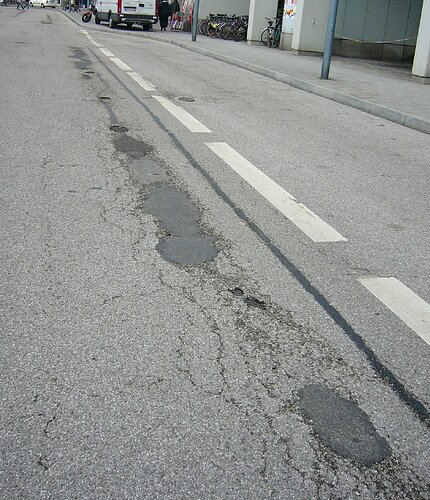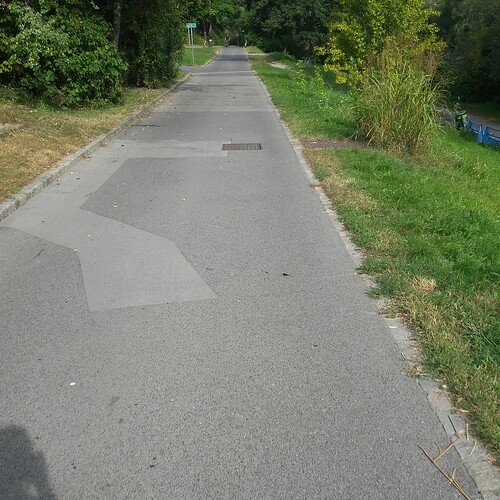Background
For quite some time after the smoothness key was introduced, the wiki contained very little guidance on how to tag it. The table did not have the “Description” column yet, and images in the photo column were frequently changed. After gaining some personal experience with smoothness tagging, I tried to write down my own practice by introducing the “Description” column. This was discussed with only a few participants on the wiki talk page and not on this forum (which I didn’t know about then). Independently, a group of mappers in Berlin also developed more detailed guidelines, summarized here. The two sets of guidelines deviate from each other esp. in the intermediate – very_bad range, where I interpreted “usable” in the note below the table as “passable” while the Berlin group interpreted it as “comfortably usable” (also because they aimed at using the tag for describing urban roads that are seldom so bad that high clearance is needed).
I started a thread about how to resolve this divergence of tagging practices in March, here. From the discussion and esp. the poll result here I concluded that a clear majority of mappers agree with my interpretation of how smoothness should be tagged.
I then started editing the smoothness gallery in my own user space here but didn’t manage to complete it and put it up for discussion until now. Compared to Key:smoothness/Gallery - OpenStreetMap Wiki I made the following changes:
Asphalt
Moved Crumbling asphalt path.jpg and Asphalt - bad.jpg from bad to intermediate (they show a surface similar to that in 20201129 114019 (2).jpg, and don’t show any potholes that would force a car to slow down considerably).
Moved Kamieniec Szalejow Gorny road.jpg from very_bad to bad (although the potholes are quite deep, a normal car can pass there, though very slowly. Having high clearance would not help, and an SUV would have to move equally slowly)
Added Asphalt - very bad.jpg and High clearance asphalt.jpg to very_bad
Concrete and concrete:plates
Moved Concrete plates - bad.jpg from bad to intermediate (does not show any potholes, no need to slow down in a car)
Paving stones
Moved Paving_stones_-_bad.jpg and Cracked_pavement.jpg from bad to intermediate (does not show any potholes, no need to slow down in a car) Paving_stones_-_bad.jpg was discussed at length here
Moved Broken sidewalk near the shore of the St. Lawrence River near Aultsville, Ontario.jpg from very_bad to bad (no need for high clearance, looks as bad as 20230418 142605c.jpg)
Sett
Moved Sett - bad.jpg and Nieborowice, Dworcowa 01.jpg from bad to intermediate (again does not show any potholes, and no need to slow down with a car). Moved Very bad sett.jpg from very_bad to bad (no need for high clearance). I am not very happy with the pictures that are now in bad. I think they are on the edge of intermediate and bad: the stones are irregularly placed, but there are no major potholes and a car would hardly have to slow down. Esp. Residential street with irregular sett paving.jpg is at the bad end of intermediate, I think. Better pictures are very welcome! In my experience, the smoothness of sett surfaces varies very little: almost all are intermediate because potholes rarely form in them.
Unhewn cobblestone
Moved Bad Radkersburg Murgasse IMG 0583.jpg and Mukulakivitie Porvoossa.jpg from bad to intermediate (although probably very noisy to drive on, it’s not necessary to slow down to prevent damage to the car, and there are no potholes). Moved 02.Trinidad (59).JPG from very_bad to bad (no obstacles that would require high clearance).
Compacted
Moved all images previously in intermediate to good (they all look very similar to me, and it would not be any problem to ride them with a racing bike. With a car you might want to slow down because of loose stones, but I think this is a property of surface=compacted; the smoothness is similar to a surface=asphalt, smoothness=good road).
Moved Compacted - bad.jpg and Rough compacted track.jpg from bad to intermediate (driving over these surfaces will cause vibrations, but there are no potholes that you need to slow down for).
Added Dirtroadpotholes.JPG to bad (a fine example of a compacted road with potholes)
Can I have your thoughts please? Do you agree with the moves, or not? Why? What would you do differently?
Unpaved
Below the table for paved&compacted surfaces, I created a new table for gravel&unpaved surfaces that shows smoothness columns for intermediate to very_horrible. I moved the gravel and fine_gravel row there and started to add pictures for unpaved roads but did not finish the job. I hope to discuss this later, when I feel it’s ready and after we have reached consensus on how to tag paved ways.
Additional pictures are very welcome, esp. for unpaved bad (these surfaces tend to go from intermediate straight to very_bad as they deteriorate: the surface is often soft enough that it is smoothed in the driving direction, so ruts form before potholes are formed).








